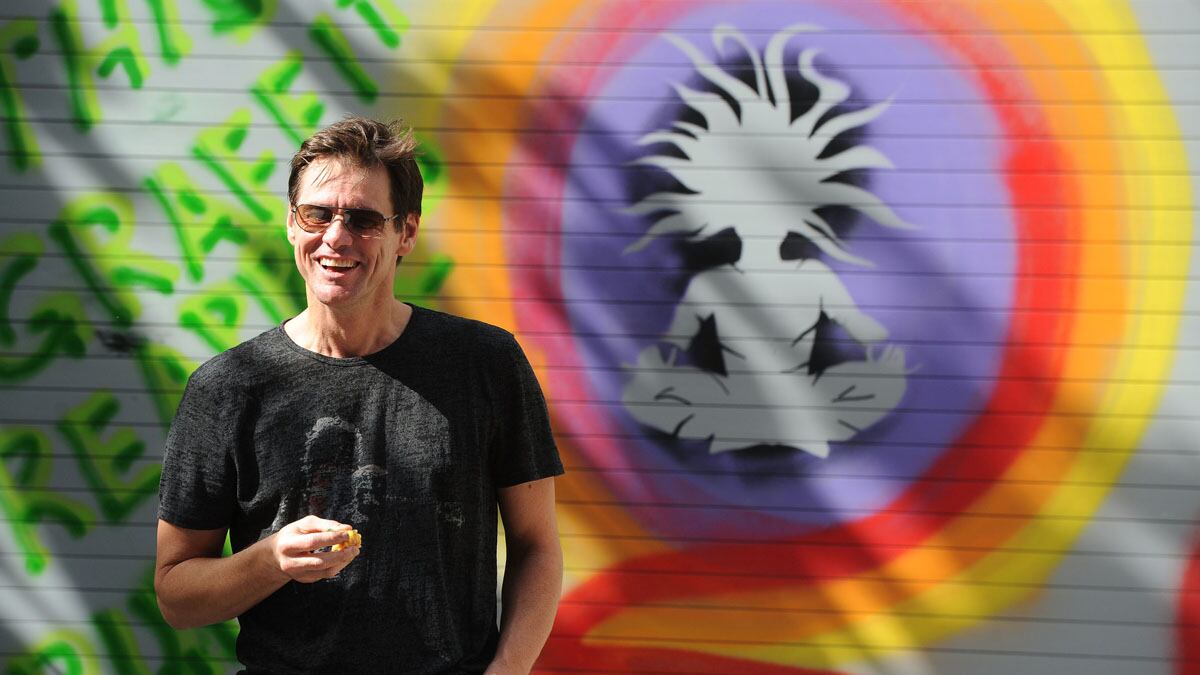The neighbors couldn’t help noticing Jim Carrey’s unusual behavior.
After acquiring an enormous, industrial workspace in New York’s tony West Village six or so months ago, the megabuck movie comedian began appearing around the neighborhood in paint-spattered cutoffs, keeping vampire’s hours, and toiling late into the night behind a giant roll-down garage door, aided by a small cadre of hipster studio assistants.
Then, one afternoon in early September, Carrey decided to take his work to the streets. Armed with several cans of vibrantly hued spray paint, the rubber-faced funnyman set to work creating a graffiti “tag” on his studio door—the stenciled silhouette of a wild-haired figure seated Indian style and levitating inside a sperm-shaped bubble accompanied by the cryptic initials “F.F.C.”
ADVERTISEMENT
“I thought that was pretty odd,” recalled West Village resident Stuart Matz, who witnessed Carrey painting the piece. “There’s a lot of odd shit in this neighborhood, but that’s definitely the weirdest. Why would Jim Carrey need to tag?”
In the aftermath of many poorly reviewed films, some of them out-and-out flops, and a messy 2010 breakup with his longtime girlfriend Jenny McCarthy, Carrey has apparently moved beyond chewing scenery on studio back lots and clocking $25 million a movie toward a new mode of creative expression.
Although there is no indication that Carrey plans to give up his baroque brand of physical screwball or his movie career anytime soon, it seems he’s found a new mojo—his #BOING, as the comedian obliquely refers to this new state of bliss on his Twitter feed. Carrey is reinventing himself as an artist.
When New York City anti-graffiti workers whitewashed Carrey’s tag last month, he took the affront seriously enough to respond by creating an even bigger mural (similarly featuring his seated levitating figure) with an attached message: “This graffiti [sic] reapplied pursuant to ordinance F.F.C.” And the actor spoke briefly with TMZ to explain his M.O.

“People are wondering what I’m doing out here,” he says, appearing contemplative and uncharacteristically subdued in the clip. “I’m having a lot of fun. Being creative. Never felt better in my life. Really having a good time. I can’t wait for people to see the art. Really. You might be surprised.”
Reacting to the city’s unilateral decision to remove art—apparently unaware it had been put there by the star of Dumb and Dumber and Eternal Sunshine of the Spotless Mind—Carrey likened his handiwork to that of the British guerrilla artist Banksy and Jean-Michel Basquiat, who parlayed his cred in late '70s graffiti circles into a career as a barrier-smashing neoexpressionist in the '80s.
“I don’t want to criticize anybody, but maybe it’s a bit short-sighted,” Carrey says. “You know, painting over art. Because, didn’t Basquiat start that way? I’m not comparing myself, but some good things came from that. Banksy. A heck of a lot of modern artists came from street art. I know they have their rules and stuff, but it’s a very light-hearted thing. It’s a little bit rebellious at this point.”
Rebellious, maybe. But Carrey has quietly pursued art as a sideline for several years. In a 2008 interview, he informed Oprah Winfrey about his painstaking efforts to create a piece of art for McCarthy: “I did a painting for Jenny, and it took me 50 hours,” adding that he painted “mostly nudes.”
Evidence of a new seriousness of artistic intent, however, began surfacing in Carrey’s tweets last year. The Bruce Almighty star posted digital images of his canvases, some vividly splashed with acrylic paint and bearing such color-appropriate titles as "Green" or "Blue Skull," text-based paintings (“Faith Hope” is a fairly straight-ahead depiction of the words Faith and Hope) and even an unsmiling Kenny Scharf–esque self-portrait. And last month, Carrey posted a video on his TruLife blog that chronicles his progress silk-screening a painting titled "Man in a Lawn Chair."
It’s hardly the kind of thing we’ve come to expect from the Gumby-limbed screen presence who so indelibly burst across pop culture by talking out of his rear end in 1994’s Ace Ventura: Pet Detective. But in the view of top-tier art adviser Barbara Guggenheim, who has aided a constellation of Hollywood A-listers—Carrey included—in assembling formidable contemporary art collections, the comedian’s artistic output falls into line with that of other actors-turned-painters such as Sylvester Stallone or Farrah Fawcett.
“The issue it speaks to is that actors are artists,” Guggenheim said. “Actors are quick to understand the visual arts. And acting is like painting. You’re painting with your body. You’ve gotten a canvas on which you are going to create something.”
More recently, Carrey seems stuck on a recurring character he calls “Baba.” In the TMZ video, he explains the name means grandfather or father or holy man. But viewed in a larger artistic context, the seated silhouette, with its wild hair and upstretched palms, seems to deliberately recall such instantly recognizable Pop Art avatars as Keith Haring’s “radiant baby” symbol or Shepard Fairey’s “Obey Giant” imagery.
As Carrey explains it, Baba is a “mischievous deity” intended to provoke inner reflection. “He exists in negative space,” Carrey says to TMZ. “He basically exists to mess with you—to have fun with you, poke fun at you. To show you yourself and your prejudices and all of your guilt and all of your stuff. And even take you to hell if he has to, to get you to turn toward the light.”
Word of his artistic pursuits has trickled into the popular consciousness just as a competing perception of Carrey has also gained traction with media watchers. In August, the star uploaded to his blog a disquieting video in which he professed undying love for 22-year-old film ingénue Emma Stone. And that clip promptly cast doubts throughout the Internet about Carrey’s sanity. “Should I be flattered or seek an order of protection?” Stone posted in response on her YouTube channel.
Of course, it’s possible that Carrey’s artistic reinvention could be part of some elaborate hoax–an avant-garde practical joke of the sort favored by the performer’s idol, Andy Kaufman (whom Carrey memorably portrayed in director Milos Foreman’s 1999 biopic Man on the Moon, winning a Golden Globe in the process).
But the anecdotal evidence overwhelmingly suggests otherwise (Carrey declined to speak for this story). In the past, Carrey has publicly laid bare his Prozac consumption and battles with depression, telling Steve Kroft in a 2009 60 Minutes interview that his prodigious talent for physical comedy was born of one abiding impulse: desperation. “I had a sick mom, man. I wanted to make her feel better,” he said. “Basically, I think she laid in bed and took a lot of pain pills. And I wanted to make her feel better. And I used to go in there and do impressions of praying mantises and weird things and whatever. I’d bounce off the walls and throw myself down stairs to make her feel better.”
Viewed through this particular lens, Carrey’s art seems like an impassioned attempt to connect with the wider world in a meaningful way that his comedic and dramatic movie roles have so far denied him.
Past midnight on a recent autumn evening, Carrey was spotted by this reporter reclining in a plastic lawn chair in front of his studio and stuffing his face with pizza. The actor was cordial to passersby, even cheerful. But he wasn’t eager to publicly discuss the earnest work that has been going on in his atelier.
“He’s in there painting his ass off for hours every day,” said Matz. “It seems like he’s trying to figure out something else other than being an actor.”
Perhaps the most poignant clue about Carrey’s current state of mind—not to mention his awareness that some people indeed think he’s gone nuts—arrived on his blog in September under the heading “Jim Answers Critics Carreyokay Style.” In the footage, shot at the live-music venue Arlene’s Grocery on New York’s Lower East Side on a “random Friday night,” Carrey performs an emotion-drenched live rendition of the Bee Gees’ “I Started a Joke” with a four-piece rock combo.
“I started a joke that started the whole world cry-ing,” he sings with comically forced sincerity. “But I couldn’t see … that the joke … was on me.”
Later in the song, Carrey revs into punk mode, pogoing up and down and repeatedly snarling at high volume: “I thought I was here to make you laugh—but the fucking joke was on me!”





